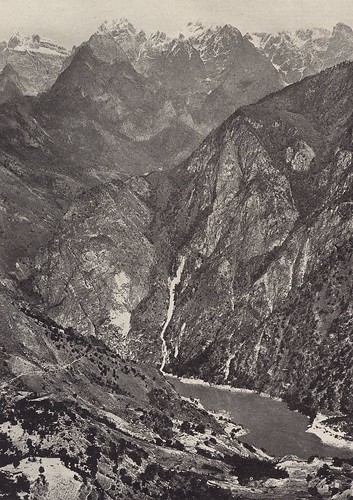Joseph Rock was one of the first westerners to 'do' the Tiger Leaping Gorge. In 1924, after his long expedition to NW Yunnan and the Dokerla pass over to the Nujiang river, he paid a visit to the gorge on his way back to Lijiang. Almost as an afterthought to his article on the trip, he wrote in the August 1926 issue of National Geographic:
"By far the finest of all the gorges in Yunnan are those through which the Yangtze flows north of Likiang, as it slashes through the mighty snow range. In grandeur these gorges may be compared with that of the Brahmaputra before it leaves Tibet for the Assam plain.
From Shiku, where the Yangtze turns north, flowing parallel to itself, the waters are broad and placid, the current gentle, and near Yulo, where a ferry plies, one would never dream that only a few miles farther on the river becomes a mad torrent flowing through a terrifying gorge.
The Yangtze flows at 6,000 feet elevation where it enters the gorge, and as the peaks of the range which it pierces as with a giant's sword are more than 19,000 feet in height, the gorge is approximately 13,000 feet in depth.
In many places the river is only 20 yards in width and is one continuous series of cascades and rapids. The actual depth of water must be enormous, for the vast placid stream is here compressed into a narrow ribbon of white foam.
The cliffs rise steeply on both sides, culminating in jagged crags and pinnacles, and above these tower the ice-crowned peaks of the Likiang snow range.
We entered the gorge after having crossed the Chungtien river, which flows into the Yangtze. A narrow trail for mules with Tibetan saddles permists ingress into Loyu, a hamlet within the gorge. From here on the path can only be used by porters and leads at times 2500 feet above the river. On the right cliff, perched in a small hollow, is a Lissu village, accesible only with great difficulty, while on the left are three small hamlets, veritable castles on the rocky bluffs. Beyond Djipalo it is possible to go down to the river bank and watch the rapids.
For three days the journey lasts until Taku is reached. Beyond Pentiwan, the third hamlet in the gorge, the trail is extremely dangerous, as rock slides occur continuously.
As the ferry at Taku was smashed by the Tibetan hordes in April 1923, and the owner placed in jail for possessing such a convenience for travellers, we were forced to return to Yulo, where we found another ferry."
Interestingly, he makes no mention of the name Tiger Leaping Gorge, nor of the legend behind the name. Instead, he simply refers to it throughout as the Yangtze gorge.
In 1994 I made a trip down the gorge, at a time when there was was only a crude trail through it. Parts of it were washed out by landslides and the track was quite hazardous. There were already some trekking lodges along the route (I stayed at Woody's at Walnut Grove). But there were also reports of trekkers being attacked by local robbers, and requests for information about trekkers who had simply disappearing in the gorge. Fallen in the river or robbed and killed? Who knows.


















